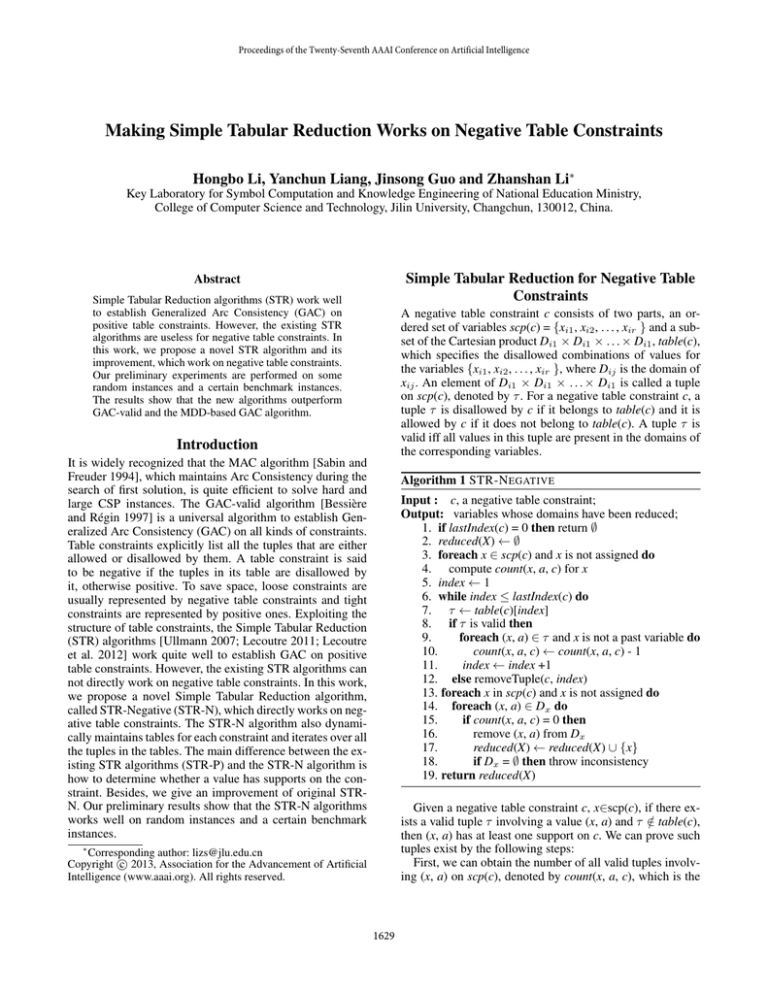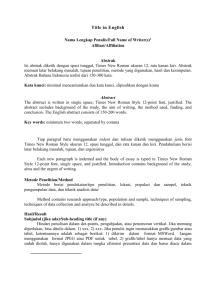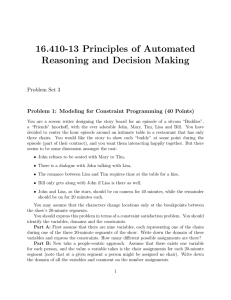
Proceedings of the Twenty-Seventh AAAI Conference on Artificial Intelligence
Making Simple Tabular Reduction Works on Negative Table Constraints
Hongbo Li, Yanchun Liang, Jinsong Guo and Zhanshan Li∗
Key Laboratory for Symbol Computation and Knowledge Engineering of National Education Ministry,
College of Computer Science and Technology, Jilin University, Changchun, 130012, China.
Simple Tabular Reduction for Negative Table
Constraints
Abstract
Simple Tabular Reduction algorithms (STR) work well
to establish Generalized Arc Consistency (GAC) on
positive table constraints. However, the existing STR
algorithms are useless for negative table constraints. In
this work, we propose a novel STR algorithm and its
improvement, which work on negative table constraints.
Our preliminary experiments are performed on some
random instances and a certain benchmark instances.
The results show that the new algorithms outperform
GAC-valid and the MDD-based GAC algorithm.
A negative table constraint c consists of two parts, an ordered set of variables scp(c) = {xi1 , xi2 , . . . , xir } and a subset of the Cartesian product Di1 × Di1 × . . . × Di1 , table(c),
which specifies the disallowed combinations of values for
the variables {xi1 , xi2 , . . . , xir }, where Dij is the domain of
xij . An element of Di1 × Di1 × . . . × Di1 is called a tuple
on scp(c), denoted by τ . For a negative table constraint c, a
tuple τ is disallowed by c if it belongs to table(c) and it is
allowed by c if it does not belong to table(c). A tuple τ is
valid iff all values in this tuple are present in the domains of
the corresponding variables.
Introduction
It is widely recognized that the MAC algorithm [Sabin and
Freuder 1994], which maintains Arc Consistency during the
search of first solution, is quite efficient to solve hard and
large CSP instances. The GAC-valid algorithm [Bessière
and Régin 1997] is a universal algorithm to establish Generalized Arc Consistency (GAC) on all kinds of constraints.
Table constraints explicitly list all the tuples that are either
allowed or disallowed by them. A table constraint is said
to be negative if the tuples in its table are disallowed by
it, otherwise positive. To save space, loose constraints are
usually represented by negative table constraints and tight
constraints are represented by positive ones. Exploiting the
structure of table constraints, the Simple Tabular Reduction
(STR) algorithms [Ullmann 2007; Lecoutre 2011; Lecoutre
et al. 2012] work quite well to establish GAC on positive
table constraints. However, the existing STR algorithms can
not directly work on negative table constraints. In this work,
we propose a novel Simple Tabular Reduction algorithm,
called STR-Negative (STR-N), which directly works on negative table constraints. The STR-N algorithm also dynamically maintains tables for each constraint and iterates over all
the tuples in the tables. The main difference between the existing STR algorithms (STR-P) and the STR-N algorithm is
how to determine whether a value has supports on the constraint. Besides, we give an improvement of original STRN. Our preliminary results show that the STR-N algorithms
works well on random instances and a certain benchmark
instances.
Algorithm 1 STR-N EGATIVE
Input : c, a negative table constraint;
Output: variables whose domains have been reduced;
1. if lastIndex(c) = 0 then return ∅
2. reduced(X) ← ∅
3. foreach x ∈ scp(c) and x is not assigned do
4. compute count(x, a, c) for x
5. index ← 1
6. while index ≤ lastIndex(c) do
7. τ ← table(c)[index]
8. if τ is valid then
9.
foreach (x, a) ∈ τ and x is not a past variable do
10.
count(x, a, c) ← count(x, a, c) - 1
11.
index ← index +1
12. else removeTuple(c, index)
13. foreach x in scp(c) and x is not assigned do
14. foreach (x, a) ∈ Dx do
15.
if count(x, a, c) = 0 then
16.
remove (x, a) from Dx
17.
reduced(X) ← reduced(X) ∪ {x}
18.
if Dx = ∅ then throw inconsistency
19. return reduced(X)
Given a negative table constraint c, x∈scp(c), if there exists a valid tuple τ involving a value (x, a) and τ ∈
/ table(c),
then (x, a) has at least one support on c. We can prove such
tuples exist by the following steps:
First, we can obtain the number of all valid tuples involving (x, a) on scp(c), denoted by count(x, a, c), which is the
∗
Corresponding author: lizs@jlu.edu.cn
c 2013, Association for the Advancement of Artificial
Copyright Intelligence (www.aaai.org). All rights reserved.
1629
fr/∼lecoutre/benchmarks.html. We have tested all the 20
Chessboard Coloration instances and 14 golombRulerArity4
instances. Table 2 presents the results for a certain instances
which cost more than 1 second and less than 1800 seconds.
product of the current domain sizes of all the variables in
scp(c) except for x. Then we iterate over all tuples of table(c), if a tuple is verified to be valid, for each value (x, a)
involved in this tuple, count(x, a, c) is decremented by 1. Finally, if count(x, a, c) is greater than 0, then value (x, a) has
at least one support on constraint c.
The STR-Negative algorithm is depicted in Algorithm 1.
Initially, the count(x, a, c) records the number of all valid
tuples involving (x, a). After iterating table(c), the number
of disallowed tuples are subtracted. Finally, count(x, a, c)
records the number of valid and allowed tuples. The lastIndex(c) points to last tuple in table(c) that has not been verified to be invalid. Whenever a tuple is verified to be invalid,
the removeTuple(c, index) first swaps table(c)[index] and table(c)[lastIndex(c)], then decrements lastIndex(c) by 1.
Initially, for each variable xi ∈scp(c), each (x, a) ∈ Di , if
the minimal count(xi , a, c) is greater than the number of all
currently valid tuples in table(c), then for each variable xi ∈
scp(c), each (xi , a) ∈ current Di has at least one support on c.
Therefore, we can avoid iterating tuples on such constraints.
The algorithm with such improvement is called STR-Ni.
Instance
cc-7-7-3
cc-10-10-2
cc-12-12-2
ruler-25-8-a4
ruler-34-9-a4
ruler-44-10-a4
GAC-v
23.15
55.98
18.89
140.36
189.42
410.41
73.99
147.39
694.71
1330.53
STR-N
15.4
31.84
13.59
95.08
116.41
208.90
33.16
54.97
313.94
488.78
STR-N
12.28
6.13
58.77
4.09
75.27
1213.47
STR-Ni
11.56
5.71
55.93
2.29
40.16
608.94
Conclusion
In this paper, we propose a novel STR algorithm suitable
for negative table constraints and its improvement. Experimental results show that the STR-N algorithms work well on
some random and benchmark instances.
Acknowledgments
This work was supported in part by the China NSFC
(61073075, 60873148) and the Science-Technology Development Project from Jilin Province of China (20120730).
We have implemented some MAC solvers which use GACvalid, mddc [Cheng and Yap 2010], original STR-N and
STR-Ni as the GAC algorithms respectively. Each solver
is equipped with dom/ddeg [Bessière and Régin 1996] as
variable ordering heuristic and the binary branching is employed. The GAC-valid (GAC-v) solver is also equipped
with the multi-directional residues technique [Lecoutre and
Hemery 2007]. Firstly, the experiments are performed on
hard random instances of Model RB [Xu and Li 2000]
situated at the phase transition of search. These instances
are generated by the RBGenerator from http://www.cril.
univ-artois.fr/∼lecoutre/benchmarks.html and are forced to
be satisfiable [Xu et al. 2005]. For each class <r, n, d, e, p>,
where r is the arity of the constraints, n is variables number,
d is the unique domain size of the variables, e is constraints
number and p is constraints tightness, 100 instances have
been tested. The average results are listed in Table 1.
mddc
21.06
48.33
17.85
135.93
225.58
407.88
96.90
145.74
1155.18
2312.29
GAC-v
25.41
7.93
70.59
3.15
51.05
690.04
Table 2: Results of a certain benchmark instances
Preliminary Experimental Results
<r, n, d, e, p>
3, 20, 10, 200, 0.206
3, 20, 10, 300, 0.142
3, 50, 5, 200, 0.331
3, 50, 5, 300, 0.235
5, 20, 5, 200, 0.149
5, 20, 5, 300, 0.102
8, 20, 3, 200, 0.104
8, 20, 3, 300, 0.071
10, 20, 3, 200, 0.104
8, 20, 3, 200, 0.104
mddc
18.62
6.64
66.00
3.44
59.11
908.87
References
Sabin, D. and Freuder, E.C. 1994. Contradicting conventional wisdom in constraint satisfaction. In Proc. of
ECAI’94, 125–129.
Bessière, C. and Régin, J.C. 1997. Arc consistency for general constraint networks: preliminary results. In Proc. of IJCAI’97, 398–404.
Ullmann, J.R. 2007. Partition search for non-binary constraint satisfaction. Information Science. 177: 3639–3678.
Lecoutre, C. 2011. STR2: Optimized Simple Tabular Reduction for Table Constraints. Constraints. 16: 341–371.
Lecoutre, C., Likitvivatanavong, C. and Yap, C. 2012. A
path-optimal GAC algorithm for table constraints. In Proc.
of ECAI’12, 510-515.
Cheng, K.C. and Yap, R.H. 2010. An MDD-based generalized arc consistency algorithm for positive and negative
table constraints and some global constraints. Constraints.
15(2): 265–304.
Lecoutre, C. and Hemery, F. 2007. A study of residual supports in arc consistency. In Proc. of IJCAI’07, 125–130.
Bessière, C. and Régin, J.C. 1996. MAC and combined
heuristics: two reasons to forsake FC (and CBJ?) on hard
problems. In Proc. of CP’96, 61–75.
Xu, K. and Li, W. 2000. Exact phase transitions in random
constraint satisfaction problems. Journal of Artificial Intelligence Research. 12: 93–103.
Xu, K. , Boussemart, F. , Hemery, F. , Lecoutre, C. 2005. A
simple model to generate hard satisfiable instances. In Proc.
of IJCAI’05, 337-342.
STR-Ni
15.62
31.53
13.96
94.80
109.38
186.60
31.17
52.00
300.30
466.92
Table 1: Results of random instances
Next, we performed experiments on Chessboard Coloration problem and Golomb Ruler problem, which involve
non-binary negative table constraints. These benchmark instances are downloaded from http://www.cril.univ-artois.
1630


